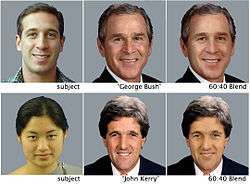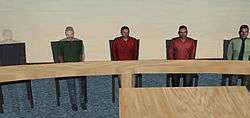Transformed social interaction
Transformed social interaction (TSI) is a research paradigm and theoretical framework related to social interaction in virtual environments.[1][2]
Overview
Virtual reality allows one to break normal rules of physical interaction because users do not actually have to share the same "reality". For example, in a collaborative virtual environment (CVE), a presenter can program their digital avatar to maintain eye contact with every person in the audience at the same time.[3] Because each member of the audience has their own view of the world, they would each think that the presenter was indeed looking at them all the time even though there are in fact many different versions of "reality" co-occurring at the same time. Three categories of TSI have been identified.
Self-representation TSIs
Dramatic and subtle changes to appearances or behaviors can be made to our avatars for social advantage. For example, a digital avatar could incorporate 20% or 40% of someone else's face. Studies have shown that both behavioral[4] and visual mimicry[5] can make a person more persuasive.
Changes in digital self-representation can also be used to modify a person's own attitudes and behaviors. For example, users in tall avatars became more aggressive in a negotiation task than users in short avatars.[6] And users placed in avatars of an elderly person held fewer negative stereotypes of the elderly in general.[7]
Social sensory abilities
A virtual environment can provide information to a person that would be considered super-human powers in real life. For example, virtual classrooms could provide teachers with updated interest/boredom level of students by tracking their eye gaze patterns, or it could alert teachers when they have not maintained eye contact with certain students in the virtual classroom for a long period of time.
Environmental transformations
Because every user sees their own version of the virtual space, different users could be in different or exactly the same spatial setting. For example, in a virtual classroom, every student could be sitting right in front of the teacher. And because a digital environment can store information, students could also "rewind" to hear part of the material again.


References
- Bailenson, J.N., Beall, A.C., Loomis, J., Blascovich, J., & Turk, M. (2004). Transformed Social Interaction: Decoupling Representation from Behavior and Form in Collaborative Virtual Environments. PRESENCE: Teleoperators and Virtual Environments, 13(4), 428-441.
- Bailenson, J. N. (2006). Transformed Social Interaction in Collaborative Virtual Environments. In Messaris, P. and Humphreys, L. (Ed.) Digital Media: Transformations in Human Communication. 255-264. New York: Peter Lang.
- Bailenson, J.N., Beall., A.C., Blascovich, J., Loomis, J., & Turk, M. (2005). Transformed Social Interaction, Augmented Gaze, and Social Influence in Immersive Virtual Environments. Human Communication Research, 31, 511–537.
- Bailenson, J. N. & Yee, N. (2005). Digital Chameleons: Automatic assimilation of nonverbal gestures in immersive virtual environments. Psychological Science, 16, 814-819.
- Bailenson, J.N., Garland , P., Iyengar, S., & Yee, N. (2006). Transformed Facial Similarity as a Political Cue: A Preliminary Investigation. Political Psychology, 27, 373-386.
- Yee, N. & Bailenson, J.N. (2007, in press). The Proteus Effect: Self Transformations in Virtual Reality. Human Communication Research.
- Yee, N., & Bailenson, J.N. (2006). Walk A Mile in Digital Shoes: The Impact of Embodied Perspective-Taking on The Reduction of Negative Stereotyping in Immersive Virtual Environments. Proceedings of PRESENCE 2006: The 9th Annual International Workshop on Presence. August 24 – 26, Cleveland , Ohio , USA
External links
- Virtual Human Interaction Lab - A research lab based at Stanford University that has an emphasis on experimental research in Transformed Social Interaction.
- Research Center for Virtual Environments and Behavior - A research lab based at UCSB that also studies Transformed Social Interaction.